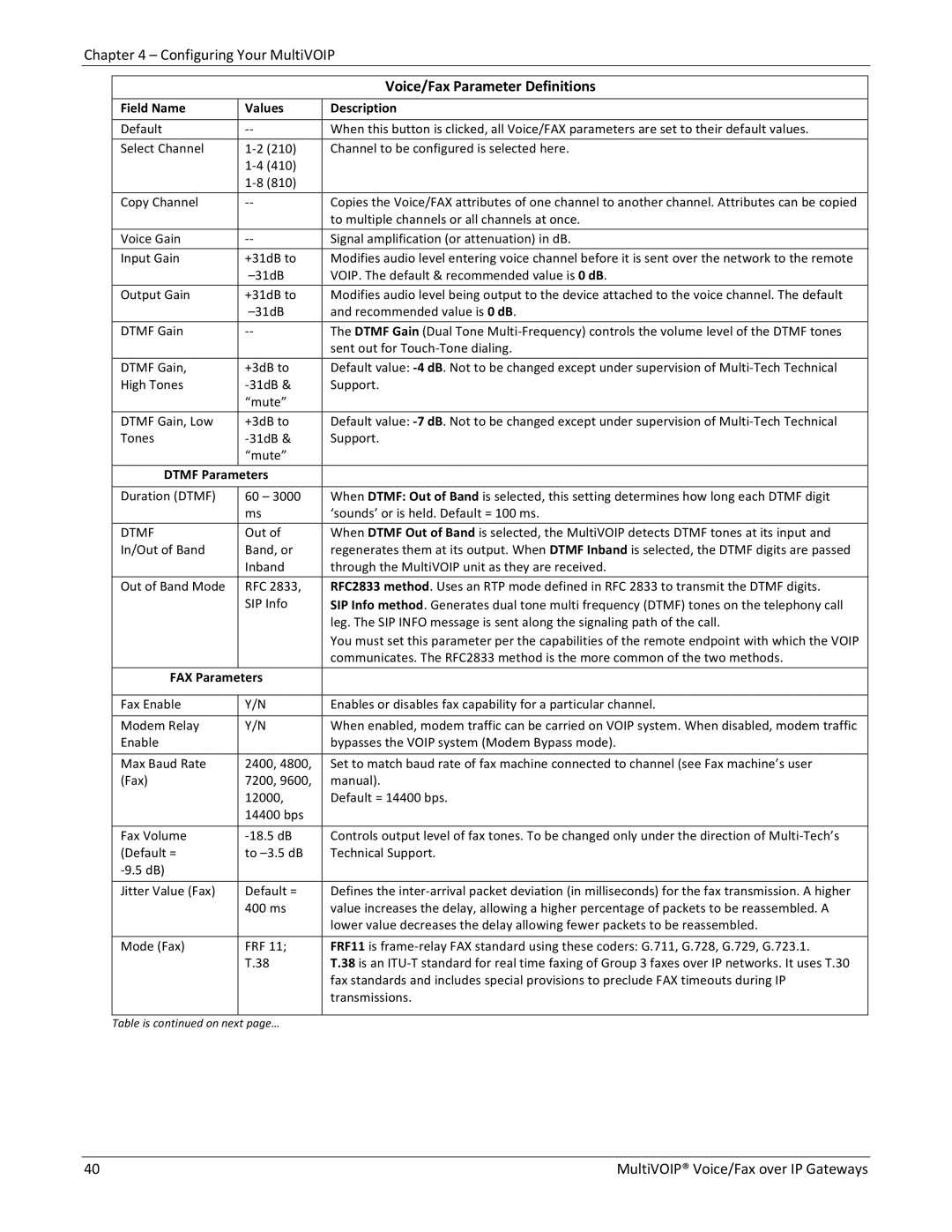
Chapter 4 – Configuring Your MultiVOIP
Field Name | Values |
|
|
Default | ‐‐ |
|
|
Select Channel | 1‐2 (210) |
| 1‐4 (410) |
| 1‐8 (810) |
|
|
Copy Channel | ‐‐ |
|
|
Voice Gain | ‐‐ |
|
|
Input Gain | +31dB to |
| |
|
|
Output Gain | +31dB to |
| |
DTMF Gain | ‐‐ |
|
|
DTMF Gain, | +3dB to |
High Tones | ‐31dB & |
| “mute” |
|
|
DTMF Gain, Low | +3dB to |
Tones | ‐31dB & |
| “mute” |
|
|
DTMF Parameters | |
|
|
Duration (DTMF) | 60 – 3000 |
| ms |
|
|
DTMF | Out of |
In/Out of Band | Band, or |
| Inband |
|
|
Out of Band Mode | RFC 2833, |
| SIP Info |
|
|
FAX Parameters
Fax Enable | Y/N |
|
|
Modem Relay | Y/N |
Enable |
|
|
|
Max Baud Rate | 2400, 4800, |
(Fax) | 7200, 9600, |
| 12000, |
| 14400 bps |
|
|
Fax Volume | ‐18.5 dB |
(Default = | to |
‐9.5 dB) |
|
|
|
Jitter Value (Fax) | Default = |
| 400 ms |
|
|
Mode (Fax) | FRF 11; |
| T.38 |
|
|
Table is continued on next page…
Voice/Fax Parameter Definitions
Description
When this button is clicked, all Voice/FAX parameters are set to their default values. Channel to be configured is selected here.
Copies the Voice/FAX attributes of one channel to another channel. Attributes can be copied to multiple channels or all channels at once.
Signal amplification (or attenuation) in dB.
Modifies audio level entering voice channel before it is sent over the network to the remote VOIP. The default & recommended value is 0 dB.
Modifies audio level being output to the device attached to the voice channel. The default and recommended value is 0 dB.
The DTMF Gain (Dual Tone Multi‐Frequency) controls the volume level of the DTMF tones sent out for Touch‐Tone dialing.
Default value: ‐4 dB. Not to be changed except under supervision of Multi‐Tech Technical Support.
Default value: ‐7 dB. Not to be changed except under supervision of Multi‐Tech Technical Support.
When DTMF: Out of Band is selected, this setting determines how long each DTMF digit ‘sounds’ or is held. Default = 100 ms.
When DTMF Out of Band is selected, the MultiVOIP detects DTMF tones at its input and regenerates them at its output. When DTMF Inband is selected, the DTMF digits are passed through the MultiVOIP unit as they are received.
RFC2833 method. Uses an RTP mode defined in RFC 2833 to transmit the DTMF digits. SIP Info method. Generates dual tone multi frequency (DTMF) tones on the telephony call leg. The SIP INFO message is sent along the signaling path of the call.
You must set this parameter per the capabilities of the remote endpoint with which the VOIP communicates. The RFC2833 method is the more common of the two methods.
Enables or disables fax capability for a particular channel.
When enabled, modem traffic can be carried on VOIP system. When disabled, modem traffic bypasses the VOIP system (Modem Bypass mode).
Set to match baud rate of fax machine connected to channel (see Fax machine’s user manual).
Default = 14400 bps.
Controls output level of fax tones. To be changed only under the direction of Multi‐Tech’s Technical Support.
Defines the inter‐arrival packet deviation (in milliseconds) for the fax transmission. A higher value increases the delay, allowing a higher percentage of packets to be reassembled. A lower value decreases the delay allowing fewer packets to be reassembled.
FRF11 is frame‐relay FAX standard using these coders: G.711, G.728, G.729, G.723.1.
T.38 is an ITU‐T standard for real time faxing of Group 3 faxes over IP networks. It uses T.30 fax standards and includes special provisions to preclude FAX timeouts during IP transmissions.
40 | MultiVOIP® Voice/Fax over IP Gateways |
